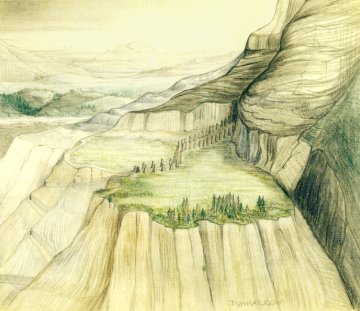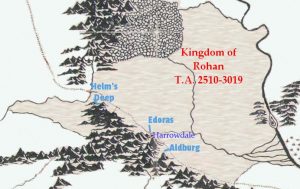Q: Why Did Théoden Assemble the Riders of Rohan in Dunharrow?
ANSWER: Dunharrow was a special refuge the Rohirrim maintained in the Ered Nimrais. It was an ancient meeting place and was used by the men of the Ered Nimrais long before Eorl led his people south to Gondor. Some months ago I received the following question:
After the Battle of Helms Deep, Theoden assembled the Riders in Dunharrow. Wasn’t that far to the East and South of the bulk of Rohan? Best answer I have come up with is the remoteness of the area would provide protection from prying eyes, but it seems days would have been added to the Muster by choosing such a place.

Technically, the Muster of Rohan was called to assemble at Edoras. Théoden sent the people of Edoras (under Éowyn’s leadership) to Dunharrow when he led all his men to reinforce Erkenbrand in the west. Later, when Gandalf rode ahead of the king’s returning party he ordered the Riders to assemble secretly in Harrowdale instead of Edoras because at least one flying Nazgul has swooped over the city.
In the story Tolkien describes the camp of about 6,000 Riders and other men near the end of the valley at the foot of the Starkhorn. There were many women and children somewhere in the vicinity as well, for Éowyn had set up camp in the Firienfield high up in the mountains.
Let us turn the question around a little bit and ask about a different point, one you yourself have partially answered. Why did Theoden return to Dunharrow first instead of to his capitol city of Edoras? Gandalf suggested this strategy to Theoden after he healed the king and they had run Gríma Wormtongue away.
‘Take back your sword, Éomer, sister-son!’ said the king. ‘Go, Háma, and seek my own sword! Gríma has it in his keeping. Bring him to me also. Now, Gandalf, you said that you had counsel to give, if I would hear it. What is your counsel?’
‘You have yourself already taken it,’ answered Gandalf. ‘To put your trust in Éomer, rather than in a man of crooked mind. To cast aside regret and fear. To do the deed at hand. Every man that can ride should be sent west at once, as Éomer counselled you: we must first destroy the threat of Saruman, while we have time. If we fail, we fall. If we succeed – then we will face the next task. Meanwhile your people that are left, the women and the children and the old, should stay to the refuges that you have in the mountains. Were they not prepared against just such an evil day as this? Let them take provision, but delay not, nor burden themselves with treasures, great or small. It is their lives that are at stake.’
‘This counsel seems good to me now,’ said Théoden. ‘Let all my folk get ready! But you my guests-truly you said, Gandalf, that the courtesy of my hall is lessened. You have ridden through the night, and the morning wears away. You have had neither sleep nor food. A guest-house shall be made ready: there you shall sleep, when you have eaten.’
‘Nay, lord,’ said Aragorn. ‘There is no rest yet for the weary. The men of Rohan must ride forth today, and we will ride with them, axe, sword, and bow. We did not bring them to rest against your wall, Lord of the Mark. And I promised Éomer that my sword and his should be drawn together.’
‘Now indeed there is hope of victory!’ said Éomer.
‘Hope, yes,’ said Gandalf. ‘But Isengard is strong. And other perils draw ever nearer. Do not delay, Théoden, when we are gone. Lead your people swiftly to the Hold of Dunharrow in the hills!’
The Rohirrim had used Dunharrow as a special refuge in times of great danger, such as during the Long Winter when Wulf, son of Freca, led a Dunlending invasion of the realm and seized Edoras. The place was located at the end of a long valley (Harrowdale) that lay south of Edoras. It was the perfect place of refuge for the king and his people, both because of its proximity to Edoras and because it lay deep in the mountains.
Most of the Rohirrim lived in the mountains. Although many fans believe the Rohirrim were a nomadic people, they only maintained their herds on the open grasslands of Calenardhon. They themselves lived in permanent communities in cities like Aldburg and Edoras, villages like Underharrow and Upbourn, and Helm’s Deep.

It may be helpful to look at a map of Rohan that I have drawn based on one of the Tolkien maps. Edoras and Harrowdale are located in the central part of the mountains. Aldburg, Eorl’s original settlement, lay further east in the Eastfold. Tolkien wrote in notes attached to “The Battles of the Fords of Isen” that Éomer lived there at the time of the War of the Ring. He was the Third Marshal of the Riddermark and he commanded the East-muster of Rohan.
Théoden’s son Théodred had, as Second Marshal of the Riddermark, commanded the West-muster of Rohan. His base was in Helm’s Deep. Erkenbrand, a former officer in the Muster of Rohan and the local lord or chieftain in Westfold Vale, took command of the West-muster after it was dispersed in the Second Battle of the Fords of Isen. All three fortified locations (Aldburg, Edoras, and the Hornburg in the Deeping Coomb) were situated so as to provide defense for the villages in the mountain valleys. Because Rohan was constantly threatened by the Dunlendings in the west and the Easterlings and Orcs beyond the Anduin, the only safe places for the Rohirrim to live were in the mountain valleys.
The Rohirrim were farmers as well as ranchers and herdsmen. This style of economy would have been consistent with the Old English and Iron Age continental Germanic and Scandinavian cultures upon which Tolkien modeled the Rohirrim.
Théoden’s party arrived last to Harrowdale. He had sent many men on to the Muster before he himself returned to the east. The 5500 Riders who assembled in the valley thus included men of Edoras but probably also some men from Westfold Vale. In the notes mentioned above, Tolkien said that at the time of the War of the Ring the official number of the Riders of Rohan was fixed at 12,000 but that there were many more men who were trained in war. In both The Lord of the Rings and “The Battles of the Fords of Isen” Tolkien mentions Rohirrim who went to war who were not Riders of Rohan. Many people have attempted to estimate how many soldiers or warriors Théoden could have raised in great need. The total number of Riders and local levies could have totaled 20,000, perhaps more, if you include men who would have been too old to serve as Riders and young men or boys who were not yet fully trained and ready to serve. Gamling the Old and his grandson served as examples in the main story of such fighters.
See also
- Who Were the Enemies of Rohan Whom Thengel and Théoden Fought?
- How Many Riders of Rohan Were There?
- Is Rohan Anglo-Saxon?
- Is Tolkien’s Rohan Similar to Germany?
Have you read our other Tolkien and Middle-earth Questions and Answers articles?

I’m interested whether there are any indications what was this place before. The presence of the pukel stones seems to imply that Druedain once lived there, of course Dark Door to the Paths of the Dead implies it was connected to their culture:
“Dividing the upland into two there marched a double line of unshaped standing stones that dwindled into the dusk and vanished in the trees. Those who dared to follow that road came soon to the black Dimholt under Dwimorberg, and the menace of the pillar of stone, and the yawning shadow of the forbidden door.
Such was the dark Dunharrow, the work of long-forgotten men. Their name was lost and no song or legend remembered it. For what purpose they had made this place, as a town or secret temple or a tomb of kings, none could say. Here they laboured in the Dark Years, before ever a ship came to the western shores, or Gondor of the Dúnedain was built; and now they had vanished, and only the old Púkel-men were left, still sitting at the turnings of the road.
Merry stared at the lines of marching stones: they were worn and black; some were leaning, some were fallen, some cracked or broken; they looked like rows of old and hungry teeth. He wondered what they could be, and he hoped that the king was not going to follow them into the darkness beyond.”
Pretty interesting, and then another thing the old man who stood watch near the entrance met by king Brego and his son Baldor:
“On the threshold sat an old man, aged beyond guess of years; tall and kingly he had been, but now he was withered as an old stone. Indeed for stone they took him, for he moved not, and he said no word, until they sought to pass him by and enter. And then a voice came out of him, as it were out of the ground, and to their amaze it spoke in the western tongue: The way is shut.”
Who was he, description seems to imply he could not have been the ‘native’ is it possible it was a Dunadan?
There are only bits and pieces of the prehistory for Dunharrow. I have mentioned them in various essays and answers. I might be able to put it all together in a future article for you.
One tidbit from “Rivers and Beacon-hills of Gondor”, Note 6:
“The Men of Darkness built temples, some of great size, usually surrounded by dark trees, often in caverns (natural or delved) in secret valleys of mountain-regions; such as the dreadful halls and passages under the Haunted Mountain beyond the Dark Door (Gate of the Dead) in Dunharrow. The special horror of the closed door before which the skeleton of Baldor was found was probably due to the fact that the door was the entrance to an evil temple hall to which Baldor had come, probably without opposition up to that point. But the door was shut in his face, and enemies that had followed him silently came up and broke his legs and left him to die in the darkness, unable to find any way out.”